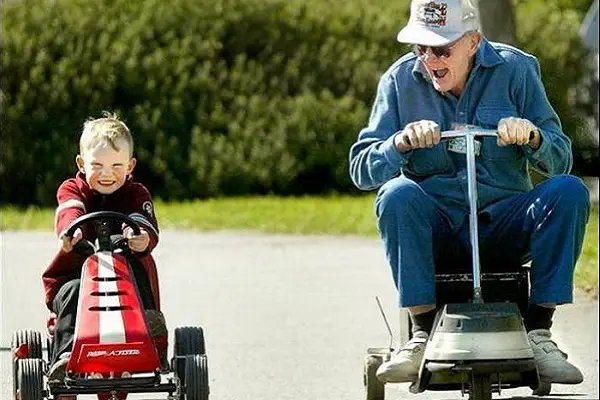
In the old days, all generations lived together to help each other, inspire each other, and share what each is best at: the older generations taught the younger generations their wisdom, the children reminded the older how to live and be happy.
This mutually-beneficial arrangement is becoming more and more rare in developed countries. Many elderly people have sadly ended up spending their last days in nursing homes with infrequent visits from their relatives.
However, we still have yet to measure the toll these decisions have taken on all generations of family. Is the price to pay for the so-called “convenience” of having the elderly generation separated and taken care of in nursing homes too high?
A first-of-its-kind experiment in the United Kingdom was created to find out. To do so, they set out to measure the health problems of the aging community living alone, and then recorded their health after six weeks of spending each day with active and happy four-year-olds.
Health of the Elderly: Before and After Children’s Visits
Most of the elderly people in the experiment did not necessarily come from happy backgrounds, but things began to change in a hurry once the kids were introduced into their daily lives.
At the beginning of the experiment the residents of a nursing home were asked a series of questions, and given tests to measure their physical and mental health levels.
The results showed:
- 1/3 experienced depression
- 9/10 found life to be unexciting
- Almost 100% had mobility problems
- Almost 100% were at risk of falling
It all drastically changed after the experiments’ scientists designed and implemented a program of exciting group activities that brought children and the elderly to “play” together. The children motivated the older generation to move more, have fun, and remember their youthful past selves.
In video footage of this experiment we see the elderly engage in the following activities:
- Showing the kids photos of their own childhood and youth
- Competing blowing up balloons using a hand pump
- Running in competitive games
- Playing badminton with a balloon
- Playing word games
- Dancing both standing or in a chair
After all of these activities, the researchers’ main questions was: Can mental and physical health be improved with this method?
The results spoke for themselves.
- 70% of the elderly reported being in a better mood
- 80% had better mobility
- Almost 100% were more excited about life
- Almost 100% reported being more active
See the video footage of the experiment from Channel 4:
Old Peoples Home for 4 Year Olds: The Experiment
The amazing outcome of The Old People's Home For 4 Year Olds…
Posted by Channel 4 on Tuesday, August 15, 2017
The last question posed by these successful experiments is: How can we make this the future of elderly care?
Other Programs Place Elderly Together with Children
The UK experiment is not the only time the older generations’ well-being was improved by being surrounded by younger generations.
These programs are gaining popularity and attention, and will hopefully be the new way of life for the aging community.
The very young and the old are sometimes called the “bookend generations,” which are often the most segregated and forgotten by the other generation aside from the immediate family (and sometimes even by them). Giving them the opportunity to spend more time together can strengthen the family bond, and the emotional well being of all members in the long run.
Another S4C documentary introduced six nursery children to adult day care facility members for three days of fun activities designed by psychologists at Bangor University.
The children in the experiment benefited from an increased attention span, and had a chance to work on their social and emotional skills.
The elderly enjoyed the new enthusiasm and energy the children brought into their lives.
But these two are not the only generations that greatly benefit from close interaction and friendship.
Universities and Retirement Communities Join Forces
In Cleveland, Ohio, college students live rent-free in a retirement community in exchange for small tasks. The students from the Cleveland Institute of Music help walk the residents’ dogs, put on weekly recitals and concerts, and help bring the life back into the lives of the residents. For the students themselves, who struggle with student loans, getting free rent is a lifesaving perk. It is a complete win-win situation.
Spending time with younger people, helps the retirement home residents fight dementia and even regulate blood pressure, among many other health benefits, reported Smithsonian.
The impact of these types of programs are bigger than many think. Research shows that almost all mental and physical problems are caused, triggered, or exacerbated by social isolation.
Social Isolation and Health Decline
Research done by the National Institute of Aging shows that social isolation alone can lead to disease. A person who feels alone has increased levels of interleukin-6 protein, which plays a key role in inflammation. Too much of it is linked to age-related, inflammation-triggered disorders:
- Alzheimer’s Disease
- Osteoporosis
- Arthritis
- Cardiovascular disease
- Cancer
This research also made the following conclusions:
- Grandparents who care for their grandchildren stay more active. They are also healthier and happier. (The same is assumed to be true for any elderly taking care of children).
- Social isolation greatly increases the risk of an early death.
- Loneliness leads to elevated blood pressure.
- Loneliness is strongly linked to depression, which in return is associated with decreased overall health for middle-age and older adults.
Universities Making Connections with Retirement Homes
While strong connections and bonds with younger people are ideal, it does not take much to create a world of difference. Rob Lucarelli at the retirement home in Cleveland called Judson Manor, said that just seeing a college student walk by puts a smile on the face of the residents.
“The people here light up when the young people walk through the lobby. It’s really quite lovely,” she said.
Luckily, there is a growing number of universities who form these arrangements with retirement communities.
Some of the senior citizen communities already cooperating with college students are:
- The Forest at Duke in North Carolina
- Holy Cross Village at Notre Dame in Indiana
- Kendal at Hanover in New Hampshire
- Kendal at Ithaca in New York
- Kendal at Oberlin in Ohio
- Lasell Village at Lasell College in Massachusetts
- Longhorn Village in Texas
- Oak Hammock at the University of Florida
- Rivers Run in New York
- The Village at Penn State in Pennsylvania
Besides the U.S., they are found in the Netherlands, France, and Finland.
In a poetic way, one retirement home resident in Finland expressed what it meant for her to have the college students as neighbors and friends:
“I once imagined being the Moon and needing the Sun, so I could shine. Now I kind of expect those youngsters to be that sun for me.”
One of the college students she was referring to had the following message for society:
“The gap between young people and the old isn’t that big that we can’t be friends, and can’t interact and get along. In the bigger picture, we can show the rest of the world that this is a good thing, and it’s worth investing in.”
Watch a TV report about young people living in a retirement home:
Recommended reading:
Loneliness Kills Faster than 15 Cigarettes a Day – Warns Former Surgeon General
Thanks for installing the Bottom of every post plugin by Corey Salzano. Contact me if you need custom WordPress plugins or website design.




